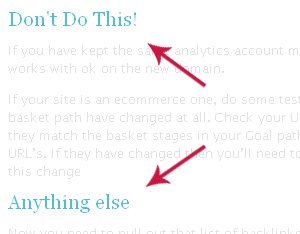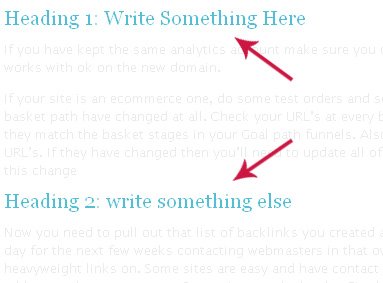The SEO and Usability of Page (Sub) Headings

I often see the page subheadings to be undervalued and underutilized, however they are great for making the page easier to scan as well as for encouraging visitors to stay and read.
So let’s discuss why the headings are important and how to make the most of them for better Internet marketing results.
Let’s start,
Markup
People may argue the overall SEO value of h1-h6 headings. The main argument is that there are plenty of websites that have a screwed structure of headings (or none at all) – and those sites do pretty well in Google. I like to answer that there are also many sites with non-existent SEO at all and many of them are ranked in top 10 for some keywords.
That being said, if you do well without correctly marked-up headings, it doesn’t mean you can’t do better once the heading structure is fixed.
Using h-heading to markup your page headings works for accessibility as well, because this makes it easier for screen readers to interpret the page.
The best practices of using h-headings include:
- There should be only one H1 heading per page;
- H1 heading should be the first heading on the page;
- Heading levels should not be skipped (e.g. H1 to H3).
Put simply, you have your main idea (H1) and then supporting facts (H2) and sometimes those supporting facts have their own supporting facts (H3).
Keywords
I don’t mean you need to stuff your heading with keywords in an effort to increase their prominence. But using the page-specific keywords throughout the headings is a good idea.
Think about usability in the first place: keywords used in the most prominent parts of the page will make it easier for visitors to associate the page with the topic and to quicker understand if that is something they are interested in:

Pattern
This one doesn’t actually relate to SEO – what it definitely will improve is your page scannability (and thus the users’ experience and engagement and increase online conversion) . Besides, it will help your content look and sound more professional, better organized, easier to digest and follow:
1. Use one and the same grammatical construction for each heading from the same level.
If you make it a sentence, let it be a sentence for all headings. If you make it a call to action (an imperative construction) or an incomplete sentence, stick to the chosen pattern for all headings of the same level. The more consistent you are, the easier it is to read and understand your document:

2. Use one and the same capitalizing pattern.
If you choose to capitalize each word in your heading, do so for each heading in the same level.

3. Subheadings should be (ideally) thematically connected with the previous-level heading:
This one is pretty clear: this makes the document logical and easy to understand: headings extracted from the page represent the summary of the text (i.e. I can guess what the page is about without reading its full content).
 Why You Should Invest in Content Marketing More than Paid Advertising
Why You Should Invest in Content Marketing More than Paid Advertising SEO is Evolving: Trend You Need to Know About [Infographic]
SEO is Evolving: Trend You Need to Know About [Infographic] Comparing GetResponse and Infusionsoft: What They Have to Offer for Marketing Your Blog
Comparing GetResponse and Infusionsoft: What They Have to Offer for Marketing Your Blog How SEO Services Can Help Increase Your Website Traffic
How SEO Services Can Help Increase Your Website Traffic
{ 31 Responses }